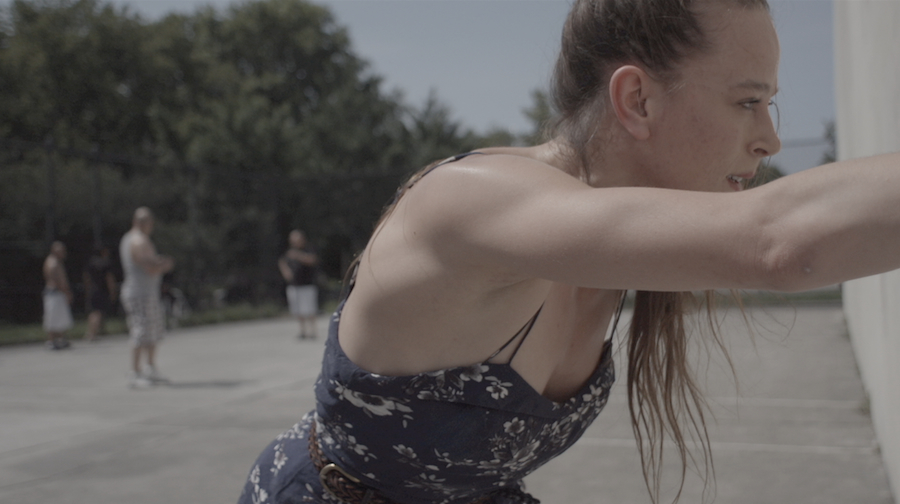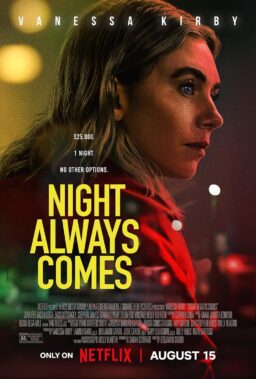Though the drug companies in America would like you to believe otherwise, there are plenty of alternative cures to ailments that don’t involve pill-popping. It was medical marijuana that brought mobility back to my mother’s body stricken with Multiple Sclerosis. Donning a self-made tail in the water proved to have a therapeutic impact on a woman in Harlem, easing her off her bipolar medication in Ali Weinstein’s charming doc, “Mermaids.” And for the titular subject of Elvira Lind’s “Bobbi Jene,” the Gaga dance method developed by Israeli choreographer Ohad Naharin helped her overcome an eating disorder. Seated with Lind’s boyfriend, Oscar Isaac, and his “Star Wars” co-star, Laura Dern, Bobbi Jene Smith opens up about what attracted her to Naharin’s Batsheva Dance Company, and to Naharin himself, whom she was romantically involved with for a time.
To her, he was an anomaly in the dance community: a straight man who loves strong women and encourages them to flaunt their flesh instead of molding them into emaciated models. Dern listens to Smith’s story in awe before reflecting on the number of movies she had to make in order to reach a similar place of healing.
Simply watching “Bobbi Jene,” one of the year’s best films, could prove to be a profoundly cathartic experience for audiences. Fresh off its well-deserved Best Documentary victory at Tribeca, Lind’s film had its Canadian premiere yesterday at Hot Docs, though the director was not present (she recently gave birth to her and Isaac’s first child). When the camera centers on Smith performing her breathtakingly physical and audacious dances, you immediately get the sense that you are observing something rare and sacred. Her hour-long performance piece, “A Study on Effort,” is an electrifying expression of female power, obliterating the shame so often associated with sexuality. At the Israeli Museum in Jerusalem, Smith begins the performance by taking off her clothes, a first step toward her intended goal of reaching a place “where I have no strength to hide anything.” The piece culminates with her pleasuring herself on a sandbag until she reaches her climax, an act that her parents back in the U.S. would never be able to watch. When her mother worries about the distress that this nudity could have on her daughter, Smith assures her that “withholding and hiding” are much more harmful to one’s psyche.
The transformative impact that Naharin’s company had on Smith is unquestionable, but she had to distance herself from it in order to find her own voice. Perched on the brink of 30, she decides to move back with her family in San Francisco after her final year with the company is up. Lind chronicles Smith’s evolution with such bracing intimacy that the film often feels more like a richly nuanced narrative drama than a documentary. We watch as Smith falls for a dancer, Or Schraiber, from Tel Aviv, who is ten years her junior but believes that “love has no age.” Their chemistry is adorable from the get-go, though it gradually becomes apparent that he has no intention of leaving his home country anytime soon.
The heartache generated by this relationship is externalized in the emotionally charged new movements conceived by Smith for what will eventually become her latest performance pieces. To practice one of the most agonizing sections of “A Study on Effort,” she pushes with all her strength against a wall, straining to move an object that, like Or, refuses to budge. During an interview with a journalist in Jerusalem, Smith describes the meaning behind another of her dance moves, where she frantically moves her arms up and down as her breathing becomes increasingly labored. She says that she was inspired by the idea of lifting something up so many times that the movement starts to appear as if it is going in reverse. “The movement doesn’t change, but the meaning flips,” Smith tells the journalist. It is this dance move, performed by a clothed Smith during her performance piece, “Harrowing,” that elicits tears from her mother. When asked why she responded so strongly, her mother speaks of how the movement conveyed the immense effort one expends when trying to resolve a conflict. That is the transcendent power great art can have on our senses, uniting us in shared feeling without having to utter a single word.

Ever since President Trump expressed his desire to defund the National Endowment for the Arts, I have been drawn to covering films that illustrate how arts programs not only serve as the voice of the people, but provide an inclusive community that can help illuminate the unrealized potential of its members. The next three Hot Docs selections in this dispatch do exactly that, making them an ideal triple bill for festgoers.
We begin with Jeff Malmberg and Christina Shellen’s “Spettacolo,” a gorgeously lensed portrait of the annual summer play put on by the citizens of Monticchiello, a tiny hill town in Tuscany. For half a century, the townsfolk have transformed their piazza into a stage, performing shows that are directly inspired by the issues facing their community. Director Andrea Cresti is seen as the troupe’s indispensable leader, and the burden of his responsibility starts to become more oppressive as their funding steadily decreases. He invites the community to speak freely during their brainstorming session for the next play, and the conversation turns swiftly toward modern anxieties—the economic crisis, the evaporation of democracy, etc. Their frustration with how poor people have been taken advantage of by rich politicians is so intense that Cresti decides to channel it into a play about a farmer who shares their plight. In an ironic turn of events, the group’s big donor—a bank—is charged with corruption, guilty of the very scandals that the performers have resoundingly condemned.
The apocalyptic tone of the town’s latest show is further fueled by the fact that very few young faces are among the performers, due to the increasing age of Monticchiello’s tight-knit population. One young man understandably prefers to play sports with people his own age rather than show up for rehearsals. Part of the problem may be the groups’ insistence on pining for the past instead of reflecting issues relevant to their youth. Like any cultural institution based in tradition, it needs young leadership in order to move forward (perhaps the local kids glued to their iPhones should get acquainted with “Julie’s Greenroom” on Netflix).
It’s telling that Cresti’s son is the owner of a B&B who believes that tourism is the town’s future. I wish the film had included more scenes of the rehearsal process itself, as well as the particulars of the show they are creating. There’s a delightful montage of citizens reciting their designated lines while going about their daily routines. Malmberg’s cinematography is so exquisite that it will undoubtedly compel more tourists to visit the town, even though the film pulls no punches in stressing how the onslaught of rich vacationers will demolish the culture of lifelong residents. A city without culture is an empty one indeed, and that is what Monticchiello is threatening to become, as their community morphs into a playground for the wealthy, renting vacation homes that spend the majority of the year unoccupied. One hopes that the locals will continue to envision their lives as “one long play,” and their village as a liberating performance space. Without these exuberant souls, the town resembles little more than a vacated soundstage.

For a few evenings in high school, I worked at a haunted house in McHenry, Illinois. The rush of exhilaration I felt every time a visitor signaled their presence by moving past a pinhole of light in the wall—visible only to your’s truly—was intoxicating. I unleashed my inner id, pushing the front half of an automobile in their direction while snapping on the headlights, honking the horn and hollering at the top of my lungs. I did that every time—until a kid who sounded like a much younger version of myself entered the room and cried, “Please don’t scare me! I’m sensitive!” Rather than retreat into my ghoulish persona, I guided him toward the exit.
I imagine Beth and Andy Watson would’ve done the same thing. They are the co-founders of Spookers, a family-run scare park that ranks as the most popular in all of New Zealand. It may seem like an odd profession for such a kindly, low-key couple to have, as evidenced by Beth’s admittance that she prefers “digging out thistles” to watching horror films. But there’s no question she takes delight in crafting the grotesque scenery, and in the opening moments of Florian Habicht’s thoroughly enjoyable “Spookers,” she turns to the cameraman and explains in a sweet voice that she’s “bloodying up two-headed babies for the incubator room.” Ed Wood would have appreciated the film’s playful opening credits sequence, where the names of crew members are written out on tombstones held by the park’s cackling performers. The Wood comparisons continue as we’re introduced to David, an actor who relishes the opportunity to wear a dress for his role as a “zombie bride,” something he would never be allowed to do in his supermarket day job.
Adding to the eerie aura of Spookers is its location at Kingseat, a former psychiatric hospital which ceased operation the same year that the Watsons designed their first corn maze. Deborah, a former patient at the institute, expresses her fear that such an attraction will further stigmatize people with mental health issues, while acknowledging that she’s not the intended audience for corn mazes (“I’ve spent 20 years in a maze,” she explains). Habicht doesn’t allow these concerns to fall on deaf ears, providing the house’s performers with a chance to reflect on the potentially upsetting implications of their work.
The director makes an intriguing choice of visualizing dreams had by some of the interview subjects, though they never quite gel with the rest of the picture. Much more effective is the footage of the subjects’ performances within the house and how they reflect their inner psyches. One performer, Juneen, enjoys venting in a theatrical context after her work in insurance claims forces her to be even-tempered with difficult clients. Her sentiments toward “corporate employment” are shared by Mary, a former nurse at Kingseat, who believes that the people running big businesses should have a psychiatric assessment, since they are often the ones causing mental health issues in others. The therapeutic impact of Spookers is witnessed in numerous participants—a dyslexic kid who overcame his shyness through acting; a young man diagnosed with HIV who derives strength from the park’s community; and the spook house’s scariest clown, who says he feels the same sense of belonging at the park that he has in the Mormon church. His performance of the hymn, “Ave Maria,” is a beautiful expression of the serenity found in the unlikeliest of places. What are haunted houses if not a safe place to be scared? “Spookers” is a celebration of strangeness rather than a mockery of it, and it is Deborah who succinctly encapsulates its communal power by observing, “If there are so many lonely people in the world, they just have to meet each other.”

Francine Valentine, the 12-going-on-13-year-old heroine of Charles Officer’s “Unarmed Verses,” is a tremendously engaging documentary subject. We first see her analyzing “The Black Cat” by Edgar Allan Poe with an exceptional attention to detail, picking apart how the story’s narrator is wrestling with himself until she exclaims, “I’ve not even done a page!” Such is the life of a true art critic. Yet there’s no question Valentine is an artist at heart. She likens reading poetry to “looking into a waterfall,” and dreams of creating a waterfall of her own. I couldn’t help being reminded of the young girl in Jim Jarmusch’s “Paterson” who writes a poem entitled “Water Falls” that leaves the film’s adult protagonist mesmerized. Like “Paterson,” “Unarmed Verses” is both about poetry and a work of poetry in itself.
Officer uses no narration or title cards to contextualize his story, opting for purely observational storytelling that enables us to share in Valentine’s trepidation and gradual blossoming as part of the Art Starts Up & Rooted music program. This film essentially takes place in Hot Docs’ backyard, namely Toronto Community Housing’s Villaways neighborhood that is set to be demolished so that its area can be “revitalized.” Valentine is one of many lifelong residents who will be relocated and likely won’t be able to afford returning home. This is a crushing blow to the young girl, who describes her beloved community members as “puzzle pieces that fit together.” She may be plagued with shyness in certain public situations, but her spirit is fierce and beckoning to be heard. That’s where her instructors at the music program come into play, encouraging Valentine to set her poetry to rhythms and notes.
At first, Francine’s reluctance is entirely reasonable, since she considers poetry and music to be two separate entities. Her mind starts to change as she witnesses the impressive work of Lavane Kelly, a 20-year-old poet at the program who composes songs that are chock-full of provocative lines like, “Ignorance is a lie if you choose to ignore it.” Officer’s camera lingers on Valentine as she looks out the window for a few wordless beats before allowing Kelly to read one of her poems. He is so taken with it that he asks her to read it aloud, but as soon as she begins mumbling, he instructs Valentine to let the importance of her words amplify her voice and sharpen her diction. Needless to say, his guidance pays off immensely. The remarkable poem that Valentine reads ends with the affirmation that all monsters fall under one name: “bully,” a word that represents everything from profit-driven forces tearing down stigmatized neighborhoods to world leaders hellbent on defunding arts programs.
“Unarmed Verses” is deserving of the audience that will likely flock to Amanda Lipitz’s “Step,” another Hot Docs selection about the empowering impact of art on young people—in this case, a high school dance team in Baltimore. Lipitz’s film is receiving distribution from Fox Searchlight, and though the film has loads of heart to spare, it is distressingly light on substance, rushing to the inspirational payoffs before fully involving us in the characters’ struggles. Officer has us wait practically the entire film for Valentine to get into the recording studio, and even then, her nerves nearly send her careening out of the room. But as soon as she opens her mouth and allows her lovely singing voice to fill the room, the audience feels as if they are watching their own child score a hard-won triumph. The director even finds a way to fulfill Valentine’s aforementioned dream in purely poetic fashion, cutting to a low-angle shot of an elevated train soaring across its track while knocking water to the ground, signaling that the gifted young woman has finally created a waterfall of her own.












